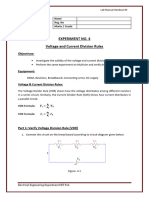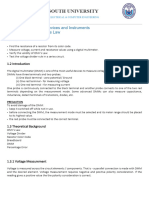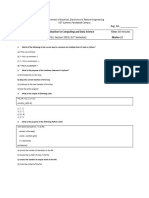Lab 01-Lab Equipment Introduction
Uploaded by
AbraizLab 01-Lab Equipment Introduction
Uploaded by
AbraizElectric Circuit Lab Manual Handout #1
Name
Reg. No
Date
Marks
EXPERIMENT NO. 1
INTRODUCTION TO LAB INSTRUMENT
Objectives:
1- To introduce the students to the basic electrical equipment in the lab.
2- To be able to deal with some of the frequently used equipment, like the digital
multimeter, breadboard, and DC Power supply.
Lab Equipment:
• DC Power Supply
• Breadboard
• DMM
• Oscilloscope
• Function Generator
General Laboratory Operating Procedures:
Listed below are the operating procedures that you are expected to follow in the
laboratory.
1. Please treat the instruments with care as they are very expensive.
2. Read the laboratory documentation prior to each lab meeting.
3. Follow the instructions carefully.
4. Return the components to the correct bin when you are finished with them.
5. Before leaving the lab place the stools under the lab bench.
6. Before leaving the lab, turn off the power to all instruments.
Digital Multimeter (DMM)
A DMM typically provides measurements for voltage, current, resistance, and may
include additional functions such as continuity testing, diode testing, and capacitance
measurement.
Electrical Engineering Department UET Fsd.Page 1
Electric Circuit Lab Manual Handout #1
To measure current, the circuit must be broken to allow the DMM to be connected in
series.
To measure voltage, DMM is connected in parallel.
To measure resistance, DMM does not function with a circuit connected to a power
supply. If you want to measure the resistance of a particular component, you must
take it out of the circuit altogether and test it separately. If you try this with the
component connected into a circuit with a power supply, the most likely result is that
the meter will be damaged. Most multi-meters have a fuse to help protect against
misuse.
Breadboard
A Breadboard is simply a board for prototyping or building circuits on. It allows you to
place components and connections on the board to make circuits without soldering.
The board is divided into rows and columns. To use the bread board, the legs of
components are placed in the holes. Each set of holes connected by a metal strip
underneath forms a node. A node is a point in a circuit where two components are
connected. Connections between different components are formed by putting their
legs in a common node.
DC Power Supply
The DC power supply is used to generate either a constant voltage (CV) or a
constant current (CC). That is, it may be used as either a DC voltage source or a DC
current source. You will be using it primarily as a voltage source. Recall that DC is
an acronym for direct current. The voltage produced by the power supply is
controlled by the knob labelled voltage. The current is limited by adjusting the knob
labelled current. As long as the circuit does not attempt to draw more current than
the value set by the current knob, the voltage will remain constant. This is often a
difficult concept for students to grasp. Current limiting allows the power supply to be
set such that it will not generate more current than it is safe. This can be useful as a
safety feature, preventing electrocution due to accidental contact with terminals. In
addition, current limiting can prevent damage to equipment and parts which may be
unable to handle excessive currents.
Oscilloscope
An oscilloscope is the most useful instrument available for testing circuits because it
allows you to see the signals at different points in the circuit. The best way of
investigating an electronic system is to monitor signals at the input and output of
each system block, checking that each block is operating as expected and is
correctly linked to the next.
Electrical Engineering Department UET Fsd.Page 2
Electric Circuit Lab Manual Handout #1
Function generator
A function generator is a device that can produce various patterns of voltage at a
variety of frequencies and amplitudes. It is used to test the response of circuits to
common input signals. The electrical leads from the device are attached to the
ground and signal input terminals of the device under test.
Most function generators allow the user to choose the shape of the output from a
small number of options.
• Square wave - The signal goes directly from high to low voltage.
• Sine wave - The signal curves like a sinusoid from high to low voltage.
• Triangle wave - The signal goes from high to low voltage at a fixed rate.
Safety Precaution
✓ Ask your instructor to check the circuit before turning on the power.
✓ Set the DMM on the resistance sign and select appropriate range.
✓ Do not connect your hands directly to the ends of resistors at the time of
measurement so that your body resistance should not come parallel to
resistance.
Procedures:
Part1: Voltage Measurement.
1- Turn on the DC Power supply.
2- Make sure that the current knob is little bit above the minimum value.
3- Adjust the voltage knob at 4.5 V.
4- Measure the voltage value using the digital multimeter, and write down the
measured value.
5- Find the percentage of error for the measured values.
6- State the reasons of the error.
Observations:
Electrical Engineering Department UET Fsd.Page 3
Electric Circuit Lab Manual Handout #1
Part 2: Resistance Measurement
Background on Resistance: Most resistors have four colored bands. The first three
bands indicate the nominal value of the resistor and the fourth band indicates the
tolerance in value.
Black Brown Red Orange Yellow Green Blue Violet Grey White
0 1 2 3 4 5 6 7 8 9
Gold Silver
+5% +10%
Figure 1: The value of the colors
For example a resistor with color code brown-black-red-silver indicates a nominal
value of 1k .
Procedures:
PART A: Resistance measurement.
1- Pick up any 5 resistances.
2- Read the value of each resistance using the color method; show your steps in
details.
3- Measure the value of each resistance using the digital multimeter.
Calculations: (Show your theoretical work here)
Electrical Engineering Department UET Fsd.Page 4
Electric Circuit Lab Manual Handout #1
Table (observations):
Resistance Measured value Calculated value
Table 1.1
PART B: Measuring the Resistance of Your Body
1. Holding one probe between the thumb and forefinger of each hand, measure the
resistance of your body between your hands. Squeeze the probes tightly so that
good contact is established. Record the value of your body's resistance.
2. Considering that a current of 100-200 mA through your heart will almost certainly
kill you, how much voltage across your hands would be lethal?
Electrical Engineering Department UET Fsd.Page 5
You might also like
- Lab 04 - Voltage and Current Division RulesNo ratings yetLab 04 - Voltage and Current Division Rules6 pages
- 4 Aims and Objectives of Creation of Pakistan100% (5)4 Aims and Objectives of Creation of Pakistan2 pages
- Fin 200 Time Value of Money Tutorial 2 Solutions 2021.100% (2)Fin 200 Time Value of Money Tutorial 2 Solutions 2021.2 pages
- Exp 1 Multimeter, Breadboard and Power Supply (2012)50% (2)Exp 1 Multimeter, Breadboard and Power Supply (2012)14 pages
- Laboratory Manual in Circuits 1 - DC Circuit Analysis0% (1)Laboratory Manual in Circuits 1 - DC Circuit Analysis35 pages
- Introduction To Developing Web Applications - NetBeans IDE Tutorial PDF100% (1)Introduction To Developing Web Applications - NetBeans IDE Tutorial PDF8 pages
- Acquintance of Electrical Lab and Its Equipments - B1No ratings yetAcquintance of Electrical Lab and Its Equipments - B115 pages
- Familiarization With Electrical Lab Equipment100% (2)Familiarization With Electrical Lab Equipment6 pages
- Computer Installation and Maintenance CTE413 REPORTNo ratings yetComputer Installation and Maintenance CTE413 REPORT8 pages
- Introduction To Laboratory Aim:: SVKM'S Nmims Mukesh Patel School of Technology Management & EngineeringNo ratings yetIntroduction To Laboratory Aim:: SVKM'S Nmims Mukesh Patel School of Technology Management & Engineering9 pages
- University of Engineering and Technology: Power Supply and Breadboard100% (1)University of Engineering and Technology: Power Supply and Breadboard7 pages
- Practical Example On Measurement & Instrumentation LabNo ratings yetPractical Example On Measurement & Instrumentation Lab36 pages
- FINAL EXPERIMENT 1 (29.11.2019) - With FigsNo ratings yetFINAL EXPERIMENT 1 (29.11.2019) - With Figs8 pages
- Background and Special Items To Note:: Wolf/Smith, Student Reference Manual For Electronic Instrumentation LaboratoriesNo ratings yetBackground and Special Items To Note:: Wolf/Smith, Student Reference Manual For Electronic Instrumentation Laboratories3 pages
- CIRCUIT TESTER and DIGITAL METER Copy 2No ratings yetCIRCUIT TESTER and DIGITAL METER Copy 230 pages
- Numerical Modelling and A Design of A Thermoelectric DehumidifierNo ratings yetNumerical Modelling and A Design of A Thermoelectric Dehumidifier16 pages
- Web Dynpro ABAP - OTR Text Translation ToolNo ratings yetWeb Dynpro ABAP - OTR Text Translation Tool10 pages
- 111 112 103 104 110 102 U V W EGR Valve MotorNo ratings yet111 112 103 104 110 102 U V W EGR Valve Motor1 page
- Likelihood Ratio Tests: Instructor: Songfeng ZhengNo ratings yetLikelihood Ratio Tests: Instructor: Songfeng Zheng9 pages
- Monocrystalline Module: Maximum Power OutputNo ratings yetMonocrystalline Module: Maximum Power Output2 pages
- Class 11 Physics Notes Chapter 10 Thermal Properties of MatterNo ratings yetClass 11 Physics Notes Chapter 10 Thermal Properties of Matter62 pages
- Digital 3-Phase Overcurrent & Ground Overcurrent Relay Manual Type: Gdr-Ab01No ratings yetDigital 3-Phase Overcurrent & Ground Overcurrent Relay Manual Type: Gdr-Ab0159 pages
- SW Full M16X2PX70 A193 B7 ZN Al SM0000000002 - BlankingNo ratings yetSW Full M16X2PX70 A193 B7 ZN Al SM0000000002 - Blanking1 page
- (David Matsumoto) The Handbook of Culture and Psyc (B-Ok - Xyz) PDF100% (1)(David Matsumoto) The Handbook of Culture and Psyc (B-Ok - Xyz) PDF475 pages
- Gas Solubility in Dilute Solutions: A Novel Molecular Thermodynamic PerspectiveNo ratings yetGas Solubility in Dilute Solutions: A Novel Molecular Thermodynamic Perspective17 pages
- Y7 Autumn Block 5 WO1 Represent Tenths and Hundredths As Diagrams 2019No ratings yetY7 Autumn Block 5 WO1 Represent Tenths and Hundredths As Diagrams 20192 pages
- Plate Load Test Din 18134 Ev1ev2 Lab FormNo ratings yetPlate Load Test Din 18134 Ev1ev2 Lab Form1 page
- Holt Algebra 2 Homework and Practice Workbook Answers100% (1)Holt Algebra 2 Homework and Practice Workbook Answers4 pages
- Fin 200 Time Value of Money Tutorial 2 Solutions 2021.Fin 200 Time Value of Money Tutorial 2 Solutions 2021.
- Exp 1 Multimeter, Breadboard and Power Supply (2012)Exp 1 Multimeter, Breadboard and Power Supply (2012)
- Laboratory Manual in Circuits 1 - DC Circuit AnalysisLaboratory Manual in Circuits 1 - DC Circuit Analysis
- A Guide to Electronic Maintenance and RepairsFrom EverandA Guide to Electronic Maintenance and Repairs
- Introduction To Developing Web Applications - NetBeans IDE Tutorial PDFIntroduction To Developing Web Applications - NetBeans IDE Tutorial PDF
- Acquintance of Electrical Lab and Its Equipments - B1Acquintance of Electrical Lab and Its Equipments - B1
- Computer Installation and Maintenance CTE413 REPORTComputer Installation and Maintenance CTE413 REPORT
- Introduction To Laboratory Aim:: SVKM'S Nmims Mukesh Patel School of Technology Management & EngineeringIntroduction To Laboratory Aim:: SVKM'S Nmims Mukesh Patel School of Technology Management & Engineering
- University of Engineering and Technology: Power Supply and BreadboardUniversity of Engineering and Technology: Power Supply and Breadboard
- Practical Example On Measurement & Instrumentation LabPractical Example On Measurement & Instrumentation Lab
- Background and Special Items To Note:: Wolf/Smith, Student Reference Manual For Electronic Instrumentation LaboratoriesBackground and Special Items To Note:: Wolf/Smith, Student Reference Manual For Electronic Instrumentation Laboratories
- Numerical Modelling and A Design of A Thermoelectric DehumidifierNumerical Modelling and A Design of A Thermoelectric Dehumidifier
- Likelihood Ratio Tests: Instructor: Songfeng ZhengLikelihood Ratio Tests: Instructor: Songfeng Zheng
- Class 11 Physics Notes Chapter 10 Thermal Properties of MatterClass 11 Physics Notes Chapter 10 Thermal Properties of Matter
- Digital 3-Phase Overcurrent & Ground Overcurrent Relay Manual Type: Gdr-Ab01Digital 3-Phase Overcurrent & Ground Overcurrent Relay Manual Type: Gdr-Ab01
- SW Full M16X2PX70 A193 B7 ZN Al SM0000000002 - BlankingSW Full M16X2PX70 A193 B7 ZN Al SM0000000002 - Blanking
- (David Matsumoto) The Handbook of Culture and Psyc (B-Ok - Xyz) PDF(David Matsumoto) The Handbook of Culture and Psyc (B-Ok - Xyz) PDF
- Gas Solubility in Dilute Solutions: A Novel Molecular Thermodynamic PerspectiveGas Solubility in Dilute Solutions: A Novel Molecular Thermodynamic Perspective
- Y7 Autumn Block 5 WO1 Represent Tenths and Hundredths As Diagrams 2019Y7 Autumn Block 5 WO1 Represent Tenths and Hundredths As Diagrams 2019
- Holt Algebra 2 Homework and Practice Workbook AnswersHolt Algebra 2 Homework and Practice Workbook Answers
































































































